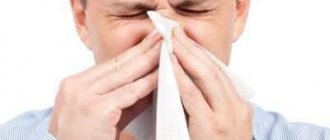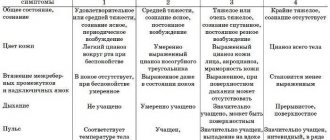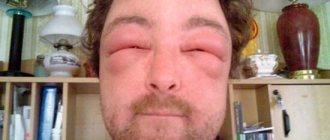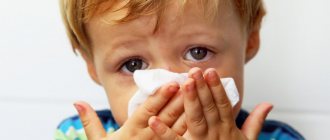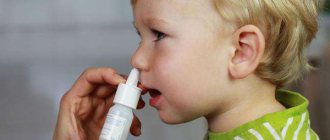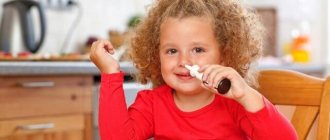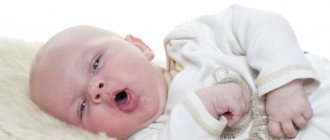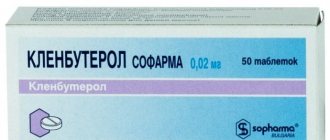What can cause a runny nose in a 10 month old baby?
A runny nose in a child (10 months old) most often develops due to an acute viral infection or allergy.
Rhinitis in children under one year of age is the most common symptom of various respiratory tract infections and other respiratory pathologies.
In a ten-month-old child, the structure of the nasal cavity with narrow nasal passages predisposes to swelling of the mucous membrane, which makes nasal breathing difficult.
The situation is complicated by the fact that babies cannot yet clear mucus from the nasal cavity on their own. A child with a runny nose has a hard time breathing, this disrupts sleep, decreases appetite, makes him capricious and restless.
If a runny nose is not treated in time, complications may arise in the form of sinusitis, pneumonia, and tonsillitis. Malnutrition due to difficulty breathing can lead to weight loss and weaken the child's body.
First of all, it is necessary to find out the cause of rhinitis.
Etiology of the phenomenon
If a runny nose is accompanied by fever, thick nasal discharge and cough, then most likely it is a viral or bacterial infection. Once on the mucous membrane, viruses penetrate epithelial cells, where they multiply, developing an inflammatory process.
At the first stage of the disease, the child has a stuffy nose, difficulty breathing, itching in the nose, and he often sneezes. The second stage of infectious inflammation of the respiratory tract is characterized by copious nasal discharge. Due to severe swelling of the mucous membrane, the baby has to breathe through his mouth, and difficulties arise during breastfeeding.
Such diseases require proper diagnosis and treatment under the supervision of a doctor.
To confirm the diagnosis, a blood test and skin testing are performed. An allergic runny nose is accompanied by attacks of sneezing, tearing, and itching in the nose. In addition, the child may have a cough, rash, and swelling of the face. Allergens can be dust, fabric, aromatic additives in soaps, creams.
Allergic rhinitis in most cases is passed on to the child from the parents.
A runny nose in a 10-month-old child may occur during teething. Non-infectious inflammation of the gums increases blood circulation in the blood vessels, touching the nasal mucosa. This is due to the fact that the gums and nasal mucosa are supplied with blood by one artery. When teething, increased blood flow equally enters the baby’s mucous membrane and gums.
As a result, the mucous membrane swells and begins to produce a lot of mucus. As a rule, when teething, nasal discharge is watery and clear, and it does not greatly interfere with breathing. As soon as the tooth erupts, the excess nasal discharge stops.
In addition, teething weakens local and general immunity, which can cause infection in the upper respiratory tract.
Treatment of rhinitis in children
How to treat a runny nose in a 10 month old baby? When the cause of a runny nose is a cold, the attending physician prescribes a course of treatment depending on the patient's condition. If necessary, antibacterial and antiseptic drugs are prescribed to combat pathogenic pathogens.
Vasoconstrictor drops help reduce swelling of the mucous membrane and eliminate nasal congestion. However, long-term use of such drugs is not recommended for ten-month-old children. Derinat nasal drops are used to suppress infection.
Many treatments are unacceptable for a child, and the statement: as I treat, so will I treat the child, is completely inappropriate here. Any medications should be prescribed exclusively by a doctor.
A child with an infectious runny nose is advised to drink plenty of fluids in the form of plain boiled water, compotes and fruit drinks. Dry heat helps with signs of a cold. It is necessary to pour dry mustard into the socks at night and give the baby a hot drink.
Since children at this age do not know how to blow their nose, parents should periodically clear their nose of accumulated mucus. To do this, use a special children's aspirator, which is a rubber bulb with a tip.
The procedure should not be carried out too often to prevent drying of the mucous membrane. It is necessary to clean your nose before breastfeeding and going to bed. Transparent watery discharge should be blotted with soft tissues. The mucous membrane should be moistened with saline or sea salt solution.
Solutions are especially good at thinning thick nasal secretions and improving their drainage.
It is necessary to ventilate the room where the child is located and monitor the air humidity. At night, you can hang a damp towel at the head of the child's bed. You can drop a few drops of eucalyptus, fir or pine essential oil onto a towel, which will provide an antibacterial effect and make it easier for your baby to breathe.
To treat a runny nose in children, you can try inhalation using a nebulizer. This is a special device that converts medicinal solutions into an aerosol and facilitates their penetration into the child’s respiratory tract. The sprayed medicine covers the entire surface of the mucous membrane, is quickly absorbed by the blood and provides a quick cure.
Nebulizers are easy to use and can be used at home. Pharmacy chains offer inhalers in the form of bright toys, which allows inhalation to be carried out in the form of an entertaining game. The main types of nebulizers convert placed medicinal solutions into steam or mist with a given size of aerosol particles.
In children of ten months, a runny nose can be treated with acupuncture. By massaging special points in the area of the wings of the nose, bridge of the nose and eyebrows with light movements, you can significantly ease your baby’s breathing.
To prevent mucus from flowing down your throat during sleep and causing coughing, you should raise the legs of the crib so that your head is slightly elevated.
How to treat a runny nose during teething? In such cases, specialized treatment is not required; the pediatrician can prescribe medications to relieve pain in the gums. During the physiological process of teething, the baby should be protected from hypothermia and the nasal passages should be cleared of mucus.
How to cure allergic rhinitis? The first condition is to eliminate the child's contact with the allergen. Antihistamines to combat a runny nose should be prescribed by your doctor. Vasoconstrictor drops do not cure allergies, but only temporarily reduce the symptoms of the disease.
For this reason, they are rarely prescribed for allergic rhinitis. Treatment methods for allergic rhinitis in children will depend on the severity of symptoms. If you have an allergic rhinitis, it is necessary to carry out daily wet cleaning in the children's room and use a humidifier, especially during the winter heating period.
Dry air irritates the mucous membrane and aggravates the course of the disease.
Prevention of runny nose in children
It is always necessary to dress your child according to the season, avoiding hypothermia and overheating of the child’s body. It is important to maintain the correct microclimate in the room; for this, it is recommended to use a humidifier.
You should avoid contact with sick children, and during flu epidemics, protect your baby from large crowds of people. It is necessary to strengthen the immune system: walk in the fresh air more often, harden the child with air baths, and monitor proper nutrition. If a baby’s runny nose continues for more than 3 days, it is advisable to stop all attempts at self-medication and go for examination to a doctor.
Source: https://NosGid.ru/bolezni/nasmork/u-rebenka-10-mesyatsev
Runny nose in children 10 months old
QUESTION ANSWER
You can treat a runny nose in a 10-month-old child with Aqualor medications without fear of any side effects.
The products are one hundred percent made from natural ingredients and do not contain preservatives, dyes or fragrances. Treating a runny nose in children under one year of age with the help of these drugs is convenient and simple. The spray can be sprayed from any angle. If a 10-month-old child has a runny nose, it is not necessary to sit him down; nasal drops or spray can be inserted into the nose even while lying down. Due to the fact that a runny nose can develop at any age, starting from birth, we have developed drugs for the little ones - Aqualor Baby Spray and Baby Drops. These preparations contain all active natural ingredients in the required proportions, which have an anti-inflammatory effect. Even if a child is 5 years old or a month old has a runny nose, you can cure a child’s runny nose in a safe way, using natural sprays and drops
How to cure a runny nose? (we are 11 months old)
Tanya
we are 9 months old, an experienced pharmacist in our pharmacy gave us Nazivin 0.01% aqueous solution for babies! from 5 weeks of life to 1 year, 1-2 drops in each nasal passage 2-3 times a day.
The runny nose went away within a day.
Daria
Need aquamaris. This is for rinsing your nose. It helps both during a runny nose and as a preventive measure. If the nose is very clogged and the child does not know how to blow his nose, an enema will help us out. You need to use a small enema to suck out the snot from your nose, otherwise it can harm your ears, and this is otitis media. You can drip brewed chamomile or horsetail flowers. And if the child is small, it is better to first consult a doctor.
Valentina
oooooooooh, well, personally, I’m probably already a pro in this matter! -) starting from 6 months and up to 11 months, I would be constantly sick, the doctors said what, but mostly they blamed it on the teeth, but I definitely understood one thing, treat or don’t treat a runny nose, but from 7-14 days it will still be there. In general, in any case, you need either aquamaris to rinse or saltine, and if you have breast milk, then instill them with it, if not, then in principle there is nothing to do with it. At first, I also sucked out the child’s snot, but it was a nightmare, I screamed as if they were killing me, and then I stopped sucking, I just wiped the snot and that’s it, but the effect was the same. So, mommies, I don’t really recommend stuffing you with all sorts of drops that They are sold for infants, it’s like the flu, don’t treat it, it’s still 7 days!
-) starting from 6 months and up to 11 months, I would be constantly sick, the doctors said what, but mostly they blamed it on the teeth, but I definitely understood one thing, treat or don’t treat a runny nose, but from 7-14 days it will still be there. In general, in any case, you need either aquamaris to rinse or saltine, and if you have breast milk, then instill them with it, if not, then in principle there is nothing to do with it. At first, I also sucked out the child’s snot, but it was a nightmare, I screamed as if they were killing me, and then I stopped sucking, I just wiped the snot and that’s it, but the effect was the same. So, mommies, I don’t really recommend stuffing you with all sorts of drops that They are sold for infants, it’s like the flu, don’t treat it, it’s still 7 days!
Lyudmila
I always instilled Aquamaris. Excellent drops. And I always use them. But you can’t instill breast milk, good flora for bacteria.
Olga
I read all the advice. I don't agree with a lot of things. Firstly, the bunch of medications that Svetlana recommended to you. I'm a little scared. One doctor also recommended Navizin for babies, and another said that Navizin simply narrows the vessels of the nose (which I already knew about adult Navizin) and is addictive. And by placing your child on Navizin, you will make him your permanent friend. The child will not be able to breathe calmly without it. Aquamaris is simply sea water. Clears the nose well. There are different types of nozzle ejectors. You need to buy a Japanese one, which works on the principle of communicating vessels (in which you draw in air through a tube. It does not injure the child’s nose. Children perceive it better, especially if they have not had time to get acquainted with other nozzle ejectors. Also, place a chopped one in the room for a while garlic or onions. Just not under the child’s nose. Have you noticed that when we cut onions our runny nose goes away? Everything gets cleared up. And the anti-flu effect at the same time. -) 
Tanyusha
As for Derinat drops, I wouldn’t recommend them at all, they’re generally allergenic; my little one got a rash from them. Aqualor helps us a lot for rinsing the nose, and then if the snot flows, you need to suck it out and drip protorgol, and if it doesn’t flow, but your nose gets stuffy, then you need to drip Nazivin or Nazol baby only for no more than 5 days. If they don’t help, then you need to buy an excellent drug called IRS 19, it helps clear and free up nasal breathing. It can be used as a preventative measure.
Irina
Derinat is an immune drug; there are practically no allergies. It does not cure a runny nose, but increases immunity, and the body itself fights better. IRS-19 is an antiviral agent, also for prevention. An allergy can be from any medicine, you need to try a little at a time. There are wonderful Oscilococcinum peas, you can drink, just read, from what age can you, from 4 years old - Cycloferon, also an immunomodulator - a cool thing, it helps a lot. But our problem developed to adenoids, a homeopath helped. You have to try and not let it go, otherwise a seemingly harmless runny nose can turn into such a nasty thing. which will lead to surgery. Aquamaris did not help us personally.
Olga
Dear moms! Thank you all for the advice! We took Oscilococcinum in early April, when we had a fever for 4 days and had a strong cough, we couldn’t do without antibiotics!
And we got a runny nose 3 days after the vaccination (DTP + poliomelitis + hepatitis), washing it did little good, and besides, the child began to go hysterical!! (N)
She began to drip Protargol 3 times a day, wiped away the snot, and if necessary, sucked it out with her mouth and spat it out. faster and more effective than snot suckers! a week and pah-pah-pah has passed!
Marina
Olga, here’s my advice, go to the ENT before it’s too late, I also treated my child’s runny nose myself, and then when we went to the doctor it turned out we had already given him everything, so he prescribed us a special medicine, the treatment took a long time, there were also warm-ups , it’s terrible how much we suffered. There is no need to self-medicate.
Marina
It is very good to rinse the nose with salt water and when the child is sleeping, warm the nose with something warm (for example, a boiled egg or heated salt).
Runny nose in a 6 month old baby
From the very first days of a child’s life, mothers sometimes simply do not know what and how to help their baby. If it’s unpleasant for an adult, then what can we say about a child. So, what to do if a 6-month-old child has a runny nose.
Runny nose in a 6 month old child: treatment
First of all, it is worth noting that a runny nose is a natural reaction of the body that helps the baby cope with viruses or bacteria in the nasopharynx. Therefore, it is not worth treating a runny nose, but you need help to cope with it.
How to help your baby, how to treat a runny nose in a 6-month-old child? The first step is to free your nose from discharge. Nowadays, special mucus suction devices have been invented for this purpose. But the most ordinary rubber bulb will do just fine.
Then drops should be instilled. In children at this age, breast milk with a warm solution is used. You just need to rinse your nose and don’t be afraid, feel free to drip 7-10 drops. Just because the milk gets into the baby’s mouth, it won’t harm him and he won’t feel bad.
Runny nose in a 6 month old child: folk remedies
You shouldn’t discount folk remedies either. Kalanchoe juice is considered an effective remedy. It needs to be dripped 3-4 drops into both nostrils and do not be afraid that the baby will start sneezing - this is natural.
The most ordinary parsley will do. The parsley must be ground, and then put in cheesecloth and squeezed thoroughly. Drop 2-3 drops of the resulting liquid into both nostrils.
Carrot or beet juice “kills” a runny nose very well. It must be diluted with water in a 1:1 ratio and boldly drip 2-3 drops into both nostrils. As practice shows, after treatment everything goes away within 2-3 days.
What should not be used for a runny nose in a child?
When treating a runny nose, never use vasoconstrictor drops! Before breastfeeding, “clean” the nose so that the baby is comfortable and does not go hungry. As you recover, crusts will form on your nose, which must be carefully “removed” with a cotton swab. The runny nose is not far behind: what to do? If your child’s runny nose does not go away after 6 months, you should immediately contact your pediatrician. It is possible that some complications have arisen.
When to see a doctor
- If your child has a high fever along with a runny nose
- If a child has a sore throat or shortness of breath along with a runny nose, there is a risk of sore throat and pneumonia.
- If, due to a runny nose, the baby refuses to drink or eat, the child may become weak after losing weight.
- If your baby has had a runny nose for more than 2 weeks
- If, along with a runny nose, a child has pain in the face or a headache, sinusitis is suspected
- If a child has repeated nosebleeds due to a runny nose, it may be that the nasal vessels are damaged
- If nasal discharge has changed from watery to purulent, this means that there is already a bacterial infection and treatment with antibiotics will be necessary.
- If a runny nose begins to develop after a child comes into contact with a known allergen (animal hair, plant pollen, detergents, food, etc.), a consultation with an allergist may be needed.
- Thuja oil for a runny nose
The human body has lost a lot of benefits due to modern technology. The mental and physical state has weakened, immunity and ability to adapt have decreased. And colds appear especially often. - Oxolinic ointment for a runny nose
Among the many different sprays and nasal drops, oxolinic ointment occupies a special place. This is a reliable medicine that has been tested by time. Oxolin is used as a medicine. - Blue lamp for a runny nose
New is well forgotten old. The invention of military doctor Minin is still popular today. This is a regular warming lamp, only blue. In the 19th century, a blue lamp for a runny nose was considered effective.How to treat a runny nose in a 7 month old baby?
Comments
HOPE
we had this. They dripped acamaris, sucked it off, then dripped derinat. four times a day. and the doctor also prescribed Erispal, 5 ml 3 times a day. three days and we were like new)))
Julia (vote)
Light
I completely agree with you, Natalya! Dear mothers! Stop torturing your kids! And yourself too! No need to use nasal drops! I suck out the child’s snot, sometimes I instill aquamaris and EVERYTHING. 2-3 days - the result is obvious. 3 years ago I had severe bilateral sinusitis, I refused punctures! I decided to stop using the above chemicals and just constantly blew my nose. I forgot about my illness, I just remembered how I suffered from terrible headaches then. And now I very rarely suffer from a runny nose! Don’t “add” the kids and try to get by yourself - you won’t regret it.
All_be_cool®
and we rinse with aquamaris 3 times a day, then use cotton pads to clean the nose from accumulated nozzles and drip Nazivin. Yulia, it not only relieves congestion, it is very effective and has a convenient dispenser pipette, which cannot be said about Nazol-baby, although it also helps
Olga
Like everyone else, we suction our sniffles, mainly before going to bed, so that we can breathe well. Before doing this, we wash it with aquamaris and then I drop it with protargol. 3 days and no runny nose.
Sources: www.aqualor.ru, www.detki-laski.ru, madam-sekret.ru, agulife.ru
Next articles:
- Neuropsychic development of preschool children
Good health to you and a speedy recovery!
More articles in this section:
Examination of children with onset presentation
How to treat a runny nose in a 10 month old baby
Inflammation of the nasal mucosa, accompanied by congestion, difficulty breathing, and sneezing, is called a runny nose.
This simple and safe (misconception of many) disease can be isolated, or can be accompanied by other pathologies.
Treatment of a runny nose in children under one year of age should be carried out with competent treatment and means, especially in infants, since there is a risk of developing serious complications.
Types of runny nose in infants
A runny nose is a commonly diagnosed inflammation of the nasal mucosa in children. It affects teenagers, school-age children, and newborn babies. In medicine, it is customary to distinguish the following types of runny nose:
- Infectious. Occurs against the background of influenza, measles, acute respiratory viral infection.
- Catarrhal (chronic). The nose has been very stuffy for a long time, and the stuffiness does not go away either day or night.
- Allergic. All signs of a runny nose appear periodically and are most often associated with the seasons of the year - for example, grass blooms in the spring, poplar fluff flies in the summer, and ragweed blooms in the fall.
- Vasomotor. It is diagnosed in children with weakened immune systems, for whom even a small draft, provided they have warm clothes, threatens to develop into a runny nose.
Read this material on how to properly use aloe juice for a runny nose.
In the case of acute rhinitis (runny nose), three stages of rhinitis can be diagnosed:
We also recommend that you read in more detail about how to treat thick snot in a child.
Runny nose in infants - features of the course
Newborns are characterized by the development of a physiological runny nose - a condition that is associated with the adaptation of the nasal mucosa to the outside world and independent breathing. In the womb, the child did not breathe through the mouth and nose - oxygen came through the blood through the umbilical cord.
After birth, the body must get used to/adapt (go through a period of adaptation) to new living conditions and the nasal mucosa simply “calculates” the required amount of mucus that should be produced. It is during this period that the baby may experience nasal congestion and the presence of mucus.
Read about the best nasal drops to use for a runny nose here.
With a physiological runny nose, the child does not experience discomfort and behaves absolutely calmly, so fever, moodiness and sleep disturbances cannot be associated with this condition.
Symptoms of a runny nose
For each stage of acute rhinitis (runny nose) there are symptoms:
- at the beginning of the disease (dry stage) – the nasal passages are dry, young patients experience unpleasant sensations (“itching”), sneeze, and a mild headache develops;
- wet stage - light-colored mucus begins to accumulate in the nasal passages, the mucous membrane swells significantly and there is complete nasal congestion;
- purulent - nasal discharge acquires a yellow-green tint, a stretchy and viscous structure.
At any stage of acute rhinitis, in addition to the above-described symptoms, headache, general weakness are added, children are capricious and require increased attention from adults. You may also be interested in learning about the treatment of yellow snot.
Snot in children is highly treatable, and in some cases, treatment of snot in children occurs without the intervention of doctors or the use of medications. If a runny nose lasts more than 3 weeks, then the risk of the disease becoming chronic increases significantly.
The causes of nasal swelling without a runny nose can be found at the provided link.
Diagnostic measures
A runny nose in an infant is diagnosed by a pediatrician already upon examination of the nasal passages - hyperemia (redness) of the mucous membrane, its swelling and the presence of mucus are noted. In some cases, instrumental methods of examining the child may be used. And more specialized specialists are invited for consultation - for example, an allergist, an infectious disease specialist.
Read about the treatment of green snot in children here.
The doctor must differentiate a common runny nose from infectious diseases in which the symptoms may be similar - for example, diphtheria, measles.
Treatment of runny nose in children from birth to 12 months
The peculiarity of a runny nose in children under one year of age is a problem in its treatment. The fact is that the baby is not able to blow his nose and the release of mucus is difficult - it accumulates in the nasal passages, which can lead to the rapid development of chronic rhinitis.
If a child sneezes and has snot, it is necessary to treat comprehensively:
- provide the necessary humidity in the child’s room - you can use special humidifiers or place containers with water, hang wet rags over the radiators;
- Regularly clear mucus from the nose using cotton swabs for children under 9 months of age or an aspirator for older children.
How to treat if a child has snot and sneezes, read this article.
Many parents put mother's breast milk into their nasal passages because it is believed to have antibacterial properties - this is a mistake! It is much more effective to use a weak saline solution for instillation (5 grams of salt in half a glass of water).
We also recommend that you familiarize yourself with cheap and effective means.
Treatment at the age of 1-12 months can last 3 or 4 days, but most often parents note final recovery a week after the start of the procedures. Albucid drops for infants are no less effective in treating a runny nose.
Drug treatment
If an infant has a runny nose, then treatment should be extremely safe - in no case should drops and aerosols/sprays, such as Snoop, which are recommended for older children, be used to relieve symptoms!
For babies aged 3 months and older, you can use Nazivin drops - they have a vasoconstrictor effect. If the baby is already 5 months old, then you can dilute the accumulated mucus in the nasal passages with a physiological solution of sodium chloride and then carry out the procedure of sucking out the liquid (aspiration). Find out how to properly rinse your child’s nose from this article.
It is also possible to take homeopathic remedies agreed with your doctor. Aquamaris is an equally effective remedy in the fight against the runny nose.
Source: https://medtehnika-plus.ru/nasmork/nasmork-u-10-mesyachnogo-rebenka-chem-lechit
Symptoms of a runny nose in a child under one year old
This disease should be distinguished from a physiological runny nose, which occurs in children under 3 months and is not dangerous to health. The body simply adjusts its work.
But if a child gets sick after 3 months, then the runny nose needs to be treated, as it interferes with normal breathing.
Basically, the symptoms of a runny nose, as in children after one year, are manifested by difficulty breathing, as well as mucus discharge from the nose. Sometimes mucus can be released freely (if it is liquid), and sometimes it can accumulate in the nasal passages, preventing the child from breathing.
Rhinorrhea in infants from 2 to 10 months
A runny nose in an infant is one of the most common complaints that a pediatrician has to listen to. Indeed, snot in a baby can cause great concern for parents, but for the patient himself it is not too dangerous, especially if it is treated promptly and correctly.
At the same time, in some cases, rhinitis in infants does not require treatment at all, and is a kind of protection against unfavorable conditions.
Thus, a runny nose in children under one year of age is often a response to too dry, hot air in the bedroom, or the presence of irritants in the air (wool, tobacco smoke, etc.).
There is also physiological rhinitis - a runny nose in a two-month-old baby and children younger, associated with the body's adaptation to conditions outside the womb.
If a baby's runny nose is not associated with a cold, parents should change the conditions in the house and not put various medications in the baby's nose.
How to understand what exactly caused a runny nose in a baby and infants up to one year old? We will talk about this in this article.
Causes of rhinitis
A baby's runny nose can have infectious and non-infectious causes. Most often, of course, snot in a child under one year of age is caused by a viral infection (ARVI).
In second place are allergic reactions, as well as hypersensitivity of the mucous membrane to non-allergic irritants (dust, tobacco smoke, household chemicals).
Bacteria cause a runny nose very rarely, but do not discount this option prematurely. Let's look at the symptoms of each of the listed types of rhinitis.
Viruses
If a child has snot every month, it is very likely that it is viral rhinitis. Viruses surround humans almost constantly, but adults, unlike children, have already developed immunity to most of them. Children are very susceptible to viral infections, and can become infected by playing with other children or communicating with adults.
Viral rhinitis is characterized by clear or white snot in infants, elevated body temperature, difficulty breathing through the nose, poor appetite (the baby does not latch on to the breast), and the baby is capricious.
Viral infections do not bother you for long - such a runny nose will go away in 4-7 days.
Treatment of viral rhinitis includes instillation of isotonic nasal drops into the nasal passages, as well as maintaining normal humidity and air temperature (if the room is hot and dry, the mucus in the nose becomes viscous and recovery is delayed).
Allergy
An unexpected runny nose in a baby without fever often indicates a respiratory allergy - a hypersensitivity reaction to a certain substance in the air.
Allergic rhinitis in an infant can be caused by inhalation of microparticles of wool, dust, pollen, etc.
This first appears in new conditions for the baby - for example, you bought a new toy, changed the powder for children's things, etc.
It is known that heredity plays a large role in the development of allergies. In addition, bottle-fed infants are more prone to allergies. It is better to treat allergies with a pediatrician and allergist. Firstly, you will have to avoid the allergen, and secondly, take antihistamines to quickly get rid of the symptoms.
Bacteria
A runny nose in a child under one year old is rarely associated with a bacterial infection, but it still happens. The following symptoms indicate this type of rhinitis:
- green or yellow snot in a baby;
- persistent high temperature;
- runny nose for more than 10 days;
- poor appetite and sleep, general malaise of the patient.
The danger of bacterial rhinitis is that it often spreads to nearby organs, resulting in the development of purulent sinusitis, otitis media and other diseases. If symptoms of bacterial rhinitis appear, consult a doctor; your baby may need antibiotics.
Teething
Often, clear snot in a baby is a sign of teething. The fact is that when teething, immunity decreases, and babies become more susceptible to various infections.
In addition, excessive mucus formation in the nose can be a consequence of increased blood flow to the gums, which is why snot appears in a 5-month-old child and older. On average, children erupt teeth from 5 months to 3 years, but sometimes a child needs a little more time - then teeth erupt longer.
In exceptional cases, teeth erupt in a child who is 4 months old, but still at 4 months a runny nose often has more trivial causes, such as a viral infection, hypothermia, etc.
Such a runny nose in a five-month-old child and older does not require treatment.
Rhinitis and the age of the baby
Snot in an infant can be caused by an infection or allergy, just like in adults. At the same time, during certain periods of development of a baby up to one year, a runny nose can occur for special reasons, which we will consider further.
From birth to 3 months
In a newborn, a runny nose is often physiological, i.e. normal.
Physiological runny nose in infants 3 months and younger is due to the fact that after birth, the nasal mucosa adapts to air humidity for some time.
In infants, the nose periodically becomes too wet. A large amount of mucous discharge may even appear - a physiological runny nose in a three-month-old child or younger.
Thus, if the child is 2 months old, a runny nose is not a disease at all. Although such rhinitis does not go away for several weeks, it does not need to be treated if the rest of the baby’s condition does not cause concern.
However, a runny nose in a child 3 months of age or younger can be associated with both a cold and allergies.
However, if a runny nose in a 2-month-old baby is associated with an infection, a lot of typical symptoms arise - cough, redness of the throat, increased body temperature. The snot of a 3-month-old child with a cold is liquid and transparent in the first days of the illness, and then thickens.
They are usually white or yellowish in color. How long does a baby’s runny nose last, and how long does it take for him to recover? Usually the disease lasts no more than 10 days.
A runny nose in a 3-month-old child with allergies is significantly different - firstly, the snot always remains clear, and secondly, an allergy attack is accompanied by severe sneezing and redness of the eyes.
The temperature of an allergic baby may be elevated.
Rhinitis in children under six months
A runny nose in a baby 4 months old is rarely physiological - in the fourth month the mucous membrane is already sufficiently developed. In most cases, a runny nose in a six-month-old baby and younger children is the first symptom of a cold, or less often of an allergy.
Parents should also make sure that the conditions in the children's room are normal (air temperature about +20C, humidity 60-70%), since a runny nose in a 5-month-old baby can be a reaction that protects the upper respiratory tract from drying out.
A runny nose in a 6-month-old child often accompanies teething, as mentioned earlier. Such snot in a 6-month-old child is liquid and transparent, not very abundant. They go away when the tooth finishes erupting.
Rhinitis in children under one year old
A runny nose in a 7, 8 and 9 month old child has the same causes - a cold, allergies or inappropriate conditions in the home. In addition, snot at this age very often accompanies teething (at this time the upper and lower incisors erupt).
It has been noticed that rhinitis occurs more often in children who have stopped breastfeeding, because mother's milk contains many antibodies to viruses.
Since most modern women stop breastfeeding during this period, children 7-12 months old quite often suffer from a runny nose, as well as from other types of colds. However, this is not a reason to prolong breastfeeding - in any case, all children will have to go through this stage.
Which drops are suitable for infants?
When a baby has a runny nose, parents are at a loss, not knowing what can and cannot be given to a cold baby. Indeed, not all medications for the common cold are suitable for infants.
When buying nasal drops for your baby, always check whether they are suitable for children under 3 years of age.
For example, almost all vasoconstrictor drops are not suitable for children under 3 years of age. However, there are also special children's forms - Naphthyzin for children, Nazol Baby, etc. But even they are suitable only if a 6-month-old baby has a runny nose, but not a baby. When using them, remember that:
- for children under 1 year of age, 1 drop is instilled into each nostril, and for children older - 1-2 drops;
- you should not use vasoconstrictors more often than four times a day;
- vasoconstrictors are used for no more than 5 days in a row (maximum course - seven to eight days);
- In case of an overdose, the patient may experience swelling of the nasal mucosa, burning sensation, sneezing, headache, and rapid heartbeat.
It is much safer to use saline solution as nasal drops. Saline solution can be purchased at a pharmacy or prepared using a liter of boiled water and a teaspoon of salt.
There are many nasal drops that act like saline - Aqua Maris, Aqualor Baby and others. They can be dripped into the nose every half hour. This solution thins thick snot in infants, making it easier for the nose to self-clean.
Breathing moist, cool air also helps thin mucus.
Many mothers prefer to treat a runny nose in a two-month-old child and even in infants using traditional medicine. Chamomile decoction (very diluted) can be considered quite safe - you can bury it in your nose twice a day. It should be remembered that medicinal plants and bee products can cause serious side effects - allergies, severe swelling, burns of the mucous membrane, etc.
How to clean your nose?
If a child 2-12 months old has a severe runny nose, the question arises - how to clear the nose and restore normal breathing? If a baby's snot is liquid, it flows out on its own and there is no need to help. If the mucus in the nose is viscous, it must first be thinned.
To do this, drip saline solution into the nose of the sick baby. Next, use a special mucus suction bulb or nasal aspirator.
These devices can be found in any pharmacy today, so there is no need to experiment using syringes, bulbs, etc.
A few recommendations:
- do not insert the tip of the bulb or aspirator too deeply into the nose; infants have a very delicate mucous membrane and can be easily injured;
- do not apply sharp pressure - this can cause otitis media in a 2-month-old baby;
- Infants should not rinse their noses using “adult” methods - using a bulb, syringe, kettle, etc.;
- Do not use cotton swabs to remove snot from infants - this is ineffective and can cause injury.
When do you need a pediatrician?
In most cases, a runny nose in a 2-month-old baby and older poses little threat to health, but parents should always be on alert, because the patient’s condition can change very dramatically.
Particular attention should be paid to such disorders as wheezing, high body temperature, which is not reduced by paracetamol, complete refusal to feed, as well as the appearance of pus and blood in the mucus.
If you notice such symptoms, or if your runny nose does not go away for more than 7 days, seek medical help.
Oksana Tsiklauri
Sources: medscape.com, health.harvard.edu, medicalnewstoday.com.
Source: https://globalmedclub.ru/rinit/deti/nasmork-u-mladenca-ot-2-do-10-mesyacev.html
A 10 month old child has a runny nose, how and what to treat?
- It is forbidden to bathe your baby for several days.
- It is contraindicated to go outside in the first days of illness, especially if, in addition to a runny nose, the temperature rises.
- Put your baby to your breast as often as possible, so he will recover faster.
- Give your one-month-old baby extra water.
Snot leads to the loss of large amounts of fluid. A one-month-old baby is allowed to give only boiled water. It is forbidden to give compote, tea, juice.
Some drops, unlike sprays, are allowed to be used for babies.
The doctor may prescribe moisturizing, antiseptic, vasoconstrictor and antiviral drops.
To relieve swelling and facilitate breathing in a baby, vasoconstrictor drops are used; they dry out a little and reduce the amount of mucus. You should not get carried away with them; strictly follow the dosage indicated in the instructions.
Place in the nose three times a day. For children, vasoconstrictor drops can be used for no more than three days. Remember that the vasoconstrictor is a potent one and often leads to various side effects.
If you do not take the dosage into account and give your baby vasoconstrictor drops too often, convulsions, vomiting, and tremors may occur. You can use Nazivin, Nazol baby for a month-old baby.
Moisturizing drops improve the condition of the mucous membrane, thin out thick mucus, and cleanse the child’s nose. In this case, drops containing sea water and saline are prescribed.
The medicine is absolutely safe. If you have a severe runny nose, be sure to rinse your baby’s nose every 2 hours.
Moisturizing drops include Aquamaris, Salin, Otrivin baby, Aqualor baby.
Sometimes the doctor prescribes antiviral drugs – Interferon, Grippferon – to speed up the baby’s recovery. Some therapists are against them; they are prescribed only to premature babies and those with problems with the immune system.
Antiseptic drops dry the mucous membrane and rid it of germs. Used if the mucus is purulent green or yellow. The best remedy is Protargol, the drug is prepared using silver. They are not available in pharmacies; they are prepared using a prescription.
Please note that antiseptic drugs, unlike vasoconstrictors, are not as dangerous, but with increasing dosage they dry out the mucous membrane and lead to burns of the nasal mucosa.
Methods for treating a runny nose in a one-month-old baby
Rarely does the baby's temperature rise; subfebral temperature up to 38 degrees can be observed; it cannot be brought down. At a temperature above 38.5, the baby must be given an antipyretic drug - Nurofen, Efferalgan, Panadol. In addition to medications, a child’s runny nose is treated with breast milk. Not everyone welcomes this method of treatment.
Traditional healers prove that mother's milk contains protective antibodies. Drops of mother's milk moisturize the mucous membrane. Opponents of this treatment method argue that milk drops are the main source of infection for a child. This is wrong! If the mother does not suffer from mastitis, a dangerous infectious disease, or hepatitis, it is allowed to drip milk into the baby’s nose.
At home, you can prepare your own saline solution. You need to take 200 ml of warm water, dissolve a quarter of a teaspoon of salt in it, so you will get an expensive moisturizing medicine.
Carrot juice is suitable for babies. To prepare it, you need to grate the carrots, squeeze them, then drop a drop into each nostril. The juice actively fights viruses, begins to irritate her a little, the child often sneezes and in this way cleans his nose.
You can prepare drops with aloe. To do this, squeeze out the juice, a few drops are enough, add warm water, and place the product in a cool, dark place. Kalanchoe cannot be used for a child, it severely irritates the nasal mucosa.
If the child has a large amount of mucus, it is necessary to use a nasal aspirator; it cleans the nose perfectly. Moisturizing drops are pre-instilled to help thin the mucus. You can use a special aspirator or a small syringe.
It is important to constantly ventilate the room. Be sure to place garlic and onions in the room; their esters have an antiviral effect. Inhalations should not be used for a one-month-old baby; this can result in laryngospasm and bronchial obstruction.
So, the treatment of a runny nose in a one-month-old baby is specific. Self-medication is prohibited, otherwise you can harm the little man.
A runny nose in a child (10 months old) most often develops due to an acute viral infection or allergy. Rhinitis in children under one year of age is the most common symptom of various respiratory tract infections and other respiratory pathologies.
A child with a runny nose has a hard time breathing, this disrupts sleep, decreases appetite, makes him capricious and restless. If a runny nose is not treated in time, complications may arise in the form of sinusitis, pneumonia, and tonsillitis.
Malnutrition due to difficulty breathing can lead to weight loss and weaken the child's body. First of all, it is necessary to find out the cause of rhinitis.
